|

Rice terraces, Bontoc, Luzon.
The Philippines: funeral of paradise
|
Few people remember it now, but the famous Kipling's poem, The White Man's
Burden, was written about the Philippines, at the time when they were seized
from Spain by the United States. The country, called "Paradise Islands"
by the Spanish for its pleasant climate and lush forests, soon obtained independence,
and, despite frequent political turmoil, became one of Asia's most successful
economies. Unfortunately, one of the White Man's gifts to the "fluttered
folk and wild" was Christianity - the country is now 83% Catholic. I don't
know to which degree the anti-condom and anti-abortion attitude of the Church
is to blame, but the statistics are depressing. The population of this Arizona-sized
country has grown to over 80 million people, with annual growth rate of about
2%. Looking at this former paradise, we can see what awaits many other countries
of the World in the next few decades.
|
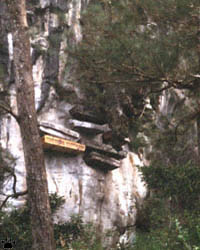
Overpopulation have lead to the development of
some unusual land-saving practices, such as
cliff burials in Mountain Province, Luzon. |
In 2001, I spent a month on the islands, in an attempt to see
what remained of their wonderful flora and fauna, before everything was gone completely.
I visited ten large and three small islands; what I saw was even worse than I
expected. Instead of becoming a happy and prosperous place, the Philippines are
now one giant city, awfully polluted and traffic-jammed; their forests are almost
completely destroyed, and hopeless people are eating their way through the surrounding
seas. All the achievements of free economy, modern science, and public education
have failed to make the people of the islands happier, because of disastrous demographic
situation. Very recently, some desperate attempts have been made to save the dying
environment, but it is way too late to stop the tide. |
| The lowland rainforests were the greatest loss. There are only
few small patches left, most of them the size of a large urban park in the US.
The Visayas (a group of islands in the central part of the Philippines, between
Luzon in the north and Mindanao in the south) have lost their lowland forests
completely, except for two tiny reserves on Bohol Island. On Luzon and Mindanao,
the largest islands, five protected areas exist, but they are gradually shrinking
because of illegal logging, and poaching is a commonplace. Park guards are few,
and unable to stop the pillaging. Small, badly degraded, and not officially protected
lowland forests also remain in Sablayan Penal Colony on Mindoro, and on Dimaguete.
And even in the most protected forests, you can often hear 2-3 chainsaws at the
same time, and gunshots every hour. |
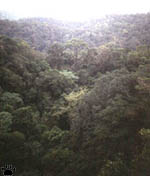
Quezon National Park, Luzon. |

Philippine pig (Sus
philippensis), Subic Bay,
Luzon. |
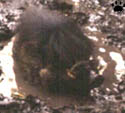
Visayan pig (S. cebifrons),
Negros Forest Foundation,
Negros. |
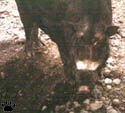
Palawan pig (S. barbatus
palawanensis), St. Paul NP,
Palawan. |
Most large animals have become extinct long ago; the remaining
few have been pushed into mountain forests, where they now barely survive on verge
of extinction. Sorry for bad photos quality - these creatures are very shy. |

Visayan deer(Cervus
alfredi), Negros Forest
Foundation, Negros. |
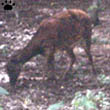
Visayan deer, Mt. Bulug,
Northern Panay
Mountains, Panay. |
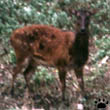
Philippine sambar (C.
mariannus), Mount Polis,
Luzon. |
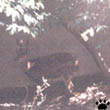
Calamian hog deer (C.
calamianensis), Bat
Island, off Palawan. |

Tamaraw (Bubalus
mindorensis), Mt. Iglit
NP, Negros. |
| As the lowland forests disappear, an uncountable number of endemic
species becomes extinct. Local conservationists, supported by international organizations,
try to save what they can, but they can only pay attention to the largest or best-known
creatures, such as ungulates, hornbills, and tarsiers. Hundreds of thousands of
other animals, plants, and fungi quietly vanish, often before even being described
by scientists. And even if a species is successfully reproduced in a zoo or botanical
garden, there is no habitat left to release it back into the wild, like in the
case of Gray's monitor (Varanus olivaceous), World's only frugivorous lizard. |
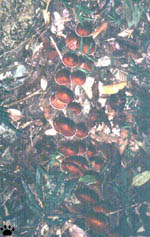 |
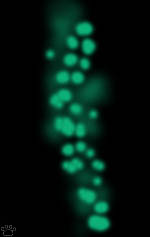 |
| Luminescent mushrooms
(probably Omphalotus), Central Cebu NP, Cebu. |
|
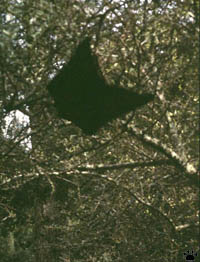 |
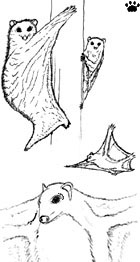 |
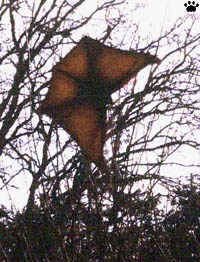 |
| Flying lemurs (Cynocephalus
volans), Rajah Sikatuna NP, Bohol. |

Mating of giant millipedes (species
unknown), Rajah Sikatuna NP, Bohol. |
Unfortunately, even small and inconspicuous creatures don't escape
attention of poachers. Butterflies, medicinal
plants, reptiles, small birds, sea horses, seashells, even millipedes are all
intensively collected for various purposes; each of these groups is targeted by
large-scale international trade. A tiny lemur called Philippine tarsier (Tarsius
syrichta), one of the World's cutest animals, has disappeared from all islands
except small Bohol, where it is bred in a special Sanctuary.
Although this nocturnal animal is extremely difficult to find in the wild, it
became victim of illegal pet trade, as well as of habitat loss and feral cats. |
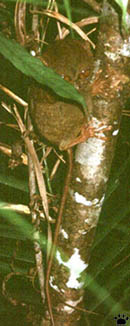 |
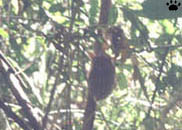
Philippine tarsier, Rajah Sikatuna NP, Bohol. |
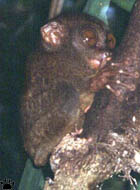 |
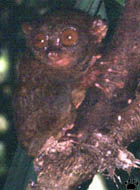 |
|
 |
| Philippine tarsier,
Tarsier Sanctuary, Bohol. |
| Plants and animals are not the only victims of deforestation.
Negrito tribes, the oldest human inhabitants of the Philippines, and other forest
peoples depended on hunting-gathering, or on slash-and-burn agriculture for their
survival. As their forest habitat is gone, their ethnical and cultural identity
is being rapidly lost. Even if their land is not invaded by loggers, the access
to modern medicine causes demographic changes, and the loss of the tribes' ability
to live off what limited land they have left. Their attempts to hold on to traditional
ways only mean that they, themselves, are hunting down and cutting down their
last remaining natural resources. |

Agta boy,
Angat,
Luzon. |

Village pond, Bongao, Tawi-Tawi. |
Most of the young Filipinos have never seen a real forest in
their life. They grow up in a world of endless villages, towns, fields, and garbage
dumps. The closest thing to natural environment left in many areas are coconut
and banana groves around more remote settlements. Although they may look attractive
to a Western tourist, they are made of less than a dozen plant species, and very
few native animals, such as rats, can survive there. There is virtually no more
arable land left in the Philippines; still, most families have 3-7 children. As
only one son can feed his family off his father's plot, others have to join the
army of city bums, or try to carve themselves a plot out of some remaining forest.
They are desperate and impossible to stop, so the forests keep shrinking. |
| Until recently, the montane forests were almost untouched on
Mindanao and the Visayas. But now fields and pastures are rapidly spreading up
the slopes. Even the best guarded national parks are not safe. The area surrounding
one of the last nests of Philippine eagle (Pithecophaga jeffryi) in Mount
Katanglad National Park, Mindanao, has been carefully protected for two decades;
in which time, the fields have advanced many miles uphill. Now the nest is surrounded
by a narrow strip of badly degraded forest, and many miles of fields, pastures
and clearcuts. On the large island of Cebu, there is less than 2 sq. km of forest
left, and all plants and animals endemic to the island are trapped in this tiny
green dot. On Negros, Leyte, Samar, and Panay, only the highest mountains are
still partly forested. |
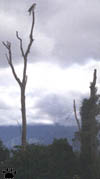
Philippine eagle in
recently logged forest,
Mt. Katanglad NP. |
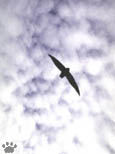
Philippine needletail
(Mearnsia picina),
Mambucal, Negros. |
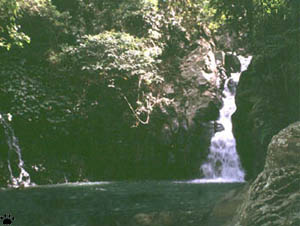
Mount Canlaon National Park, Negros. |
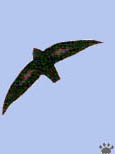
Philippine needletail is now
rare; it has probably never
been photographed before. |
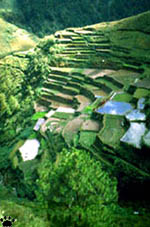
Rice terraces, Sagada, Luzon. |
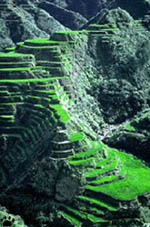
Rice terraces, Banaue, Luzon. |
On the island of Luzon, the agriculture has never been confined
to lowlands. In the extensive montane areas of Northern Luzon, rice and vegetable
terraces have been built by local people for as long as 2000 years. As a result,
even the steepest slopes have been cleared to the altitude of approximately 2000
m (6600'). The original pine forests still remain in many areas, although they
are mostly stripped of undergrowth. Dense cloud forests are now confined to very
few highest peaks. |
 |
 |
 |
 |
| Rice terraces, Banaue,
Luzon. |
Vegetable terraces,
Catubo, Luzon. |
| These cloud forests are home to some of the less known animals
and plants on Earth. They are formed by a bizarre mixture of plants of northern
and southern origin, such as pines (Pinus kesyia), alders (Alnus),
podocarps (Podocarpus), and tree ferns (Cyathea), but usually they
are dominated by oaks (Quercus). There are dozens of endemic birds and
mammals here, but some of them have not been seen for many decades, and nobody
knows if they are already extinct or not. |
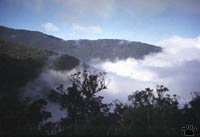
Cloud forests of Mt. Polis, Luzon. |
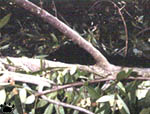
Cloud rat Crateromys
schadenbergi, Mt. Data, Luzon. |
At least 18 species of rats are endemic to Luzon. Most of them
can be seen in cloud forests of Mount Data, including cute, fluffy arboreal creatures,
known to scientists as "cloud rats", and to locals as "squirrels". They are very
vocal and easy to hear, but difficult to see. Locals hunt them regularly, so some
species are probably extinct already. The photo to the left is the only one ever
taken in the wild. Other species are more terrestrial, and some, collectively
known as shrew-rats, seem to spend most of time in forest litter. |
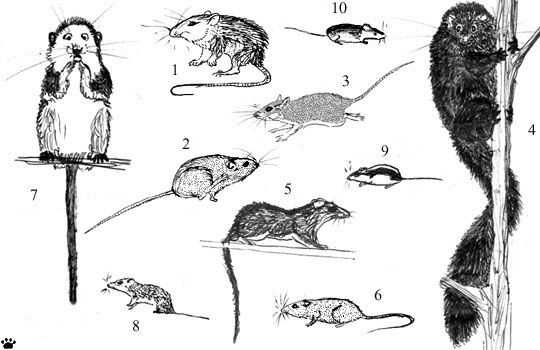
Rats of Mount Data: 1-Abditomys latidens, 2-Tryphomys adustus,
3-Apomys datae, 4-Crateromys schadenbergi, 5-Capromys
melanurus, 6-Batomys granti, 7-Ploeomys cumingi, 8-Rhynchomys soricoides, 9-Chrotomys
whiteheadi, 10-Celaenomys silaceus.
Ballpen sketches from field diary. (Photos of cloud rats and many other Philippine
animals can be seen at Samir Aragon's site).
|
| The nights I have spent in search of rare
rodents on Mount Data were full of unexpected findings. The pictures below are
actually two scans of the same slide, taken with different resolution. They show
a small bird called brown-banded rail, never before seen alive by an ornithologist
(it was described from few specimens caught by local bird trappers). Now I know
where it lives, and what does its voice sound like. Few weeks later, I heard it
in Southern Luzon, on Mayon Volcano, where small
remaining cloud forests are, to some degree, protected by frequent volcanic activity.
|

Alders and tree ferns,
Mount Data, Luzon. |
 |
 |
| Brown-banded rail (Lewinia
mirificus), Mount Data, Luzon. |
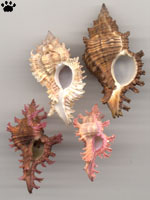
Chicoreus shells, Palawan, 0 m. |
In the same way as humans destroy
the environment higher and higher on mountain slopes, they go deeper and deeper
into the ocean, mostly in search of food. Shallows and reefs around the Philippines
are now mostly "dead zone" because of overfishing and overpolluting. I had a chance
to make a submersible dive to 1000 m (3300') off Cebu Island, and found the sea
bottom covered with endless tracks of trawling. Originally, trawling was only
done for fish and edible invertebrates, but now coral and sea shells are the best
catch. There are large coastal communities, such as Punto Engano on Mactan, specializing
in catching seashells for souvenirs and private collectors. You can see their
catch in any shell store of USA, Japan and Europe: Philippines have more species
of beautiful shells than any other country in the World. |
| This trade will not exist for long. Even the rarest species are
sold to dealers by hundreds, and cheaper, more common shells - by truckloads.
A visit to "shell factories" of Mactan was probably the most nightmarish experience
in 15 years I've been travelling around the World. Very soon most local mollusks
will follow sea horses and sea snakes, which are already almost extinct in the
area. What will not be caught by fishermen, will perish because of habitat destruction.
It is as bad in the sea as on land, just less visible. Even if not dynamited or
poisoned by cyanide, reefs die because of pollution, or are buried alive by murky
runoff from deforested islands. |
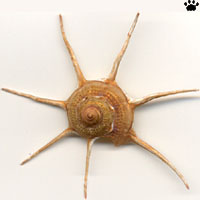
Guildfordia yoka, off Cebu, 300 m. |

Snails Helicostyla sp. (2 shells), Naninia sp., Amphidromus
sp.
Makahambus caves, Mindanao. |
Shells of land snails are seldom sought by collectors.
But in the Philippines they are so beautiful, that hundreds of thousands are exported
for souvenirs. Many species are already extremely rare. Larger snails are routinely
gathered for food. |
Freshwater fauna is also quickly disappearing.
Even fishes as small as 2 cm (1") are commercially harvested. Turtles, crocodiles,
and aquatic snakes are almost extinct.
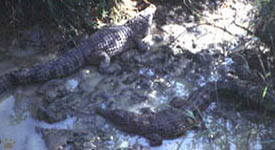
Philippine crocodiles (Crocodilus mindorensis), Kata Marsh,
Palawan.
|
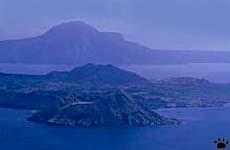 Taal Caldera with Lake Taal and inner cones, Luzon -
Taal Caldera with Lake Taal and inner cones, Luzon -
habitat of the World's only freshwater sea snake,
endangered Hydrophis semperi. |
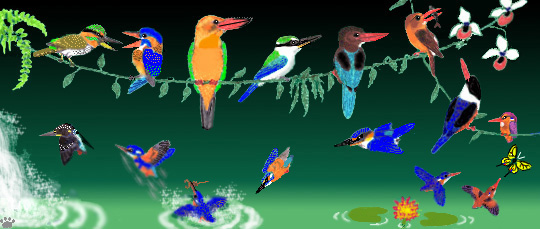
| Kingfishers of the Philippines: 1-Actenoides lindsayi, 2-A.
hombroni, 3-Halcyon capensis, 4-H. chloris, 5-H. smyrnensis, 6-H. coromanda, 7-H.
pileata, 8.-H. winchelli, 9-Alcedo atthis, 10-A. meninting, 11-A. cyanopectus,
12-A. argentata, 13-Ceyx erithaca, 14-C. melanurus, 15-C. lepidus. Painted
in Adobe Photoshop. |
 |
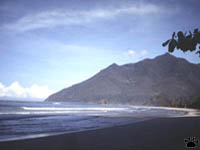
Honda Bay, Palawan. |
Palawan Island in the far southwest
of the Philippines is a world apart. Its pillaging only started a decade or two
ago, so the island is still 40% forested. There are beautiful forests in the island's
national park, and its underground rivers probably
shelter one of the richest cave faunas in the World. There are even some live
reefs around, such as in Honda Bay (where they are protected by gunboats, and
this reduces poaching to some extent). Diving here is your last chance to see
the underwater wonders of the Philippines: forests of giant black coral, splendid
coral fishes, bizarre mollusks. Migratory species, such as dugong, sea turtles,
sharks and sea snakes, are, of course, already gone from this tiny island of safety
in the ocean filled with fishing nets and floating garbage. |
| Unfortunately, despite all efforts by local authorities, Palawan
is doomed to follow other islands on their way to complete loss of biodiversity.
In addition to local population growth, there is an increasing flow of immigrants
from other provinces. Endangered Philippine cockatoos (Cacatua haematuropygia),
and pelts of wild cats are routinely sold
on Manila markets - the best place in the country to see rare fauna. Another problem
is that flora and fauna of Palawan are more similar to those of Indonesia than
to the rest of the Philippines, so many Philippine plants and animals simply do
not occur in Palawan's national park. |
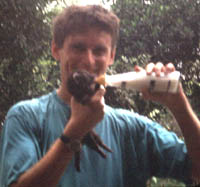
Baby palm civet (Viverra tangalunga),
confiscated from pet dealers, Manila. |
|
|
In a few years, they'll all be gone, together with the last forests
of Luzon, Mindanao and other islands, while on Palawan the total destruction will
only be complete in two-three decades. |
| Some animals and plants are endemic to Palawan. Others, such
as binturong (Arctitis binturong), also occur in other parts of Asia, but
are even more rare and endangered elsewhere. |
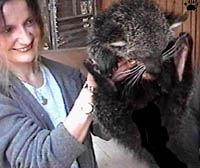 |
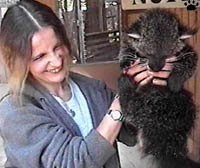 |
| Baby binturong, West
Coast Game Park, Bandon, Oregon. |
|
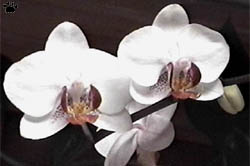
Phalaenopsis orchids (possibly introduced), Mindoro. |
It is probably too late now to save the wonderful island
paradise of the Philippines. The country and its friendly, peaceful, fun-loving
people are beyond hope or help. But there are other places, where the total destruction
of the environment is just one step behind: most countries of tropical Asia, Latin
America, parts of Africa. The only way to save their flora and fauna is to slow
down the population growth. Think about it when you vote for a "pro-life" candidate,
or against teaching family planning in schools. |

Celestial (Hypothymis caelestis), short-crested (H. helenae),
and black-naped (H. azurea) monarchs, Angat Reservoir, Luzon. Watercolor.
Tips for naturalists travelling in the Philippines can be found here
Home
|



